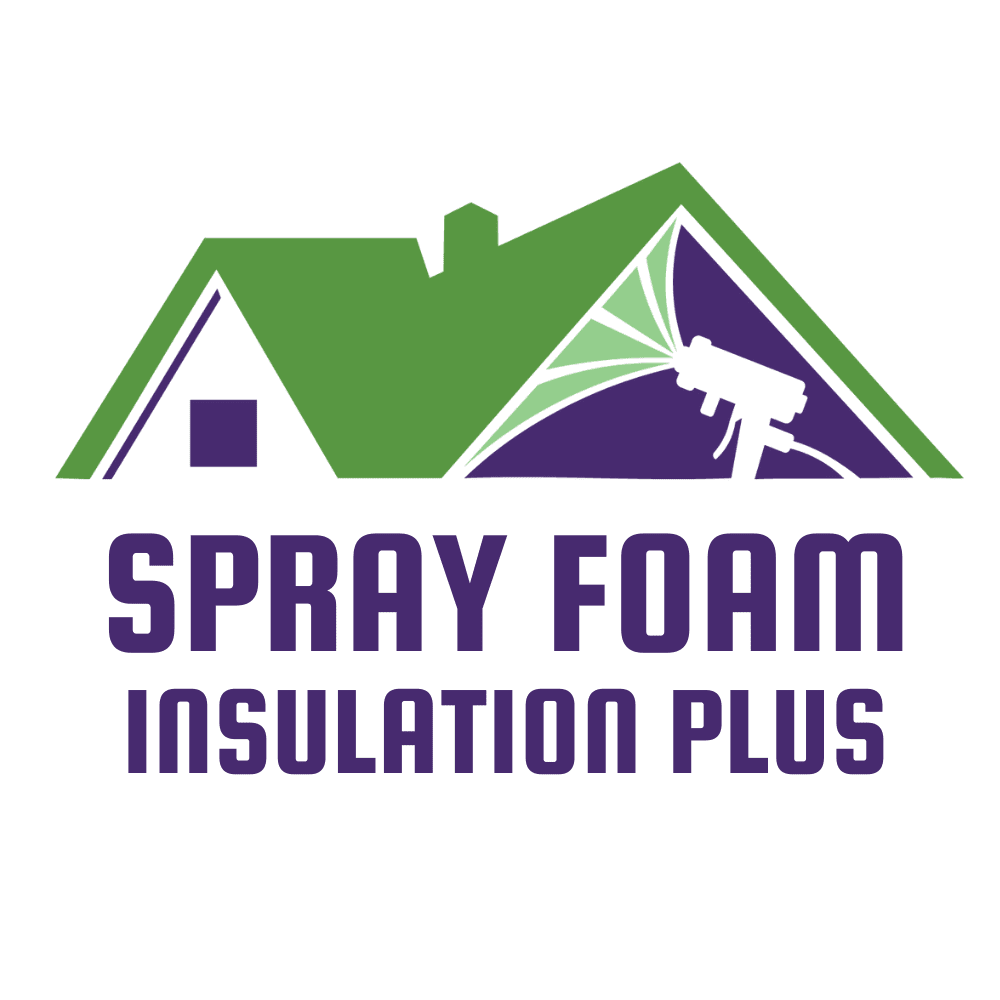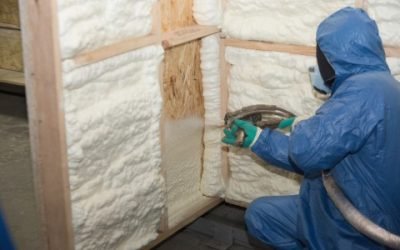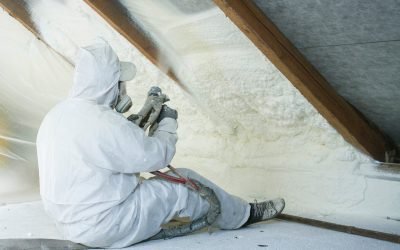Can Mold Grow on Spray Foam Insulation?

Last Updated on June 5, 2024 by Spray Foam Insulation Plus
Spray foam insulation is a common home improvement project. It’s an environmentally-friendly way to keep your house warm in the winter and cool in the summer. Have you wondered: can mold grow on spray foam insulation? Does it ruin the insulation, making it less effective at keeping heat out or air in? The short answer is no—mold won’t grow unless there’s moisture present. Spray foam does not allow water through its pores (which are much smaller than those found in fiberglass), so if there isn’t any moisture around for mold spores to land on, then you won’t have any problems with mold growth. This means you can rest assured that if you choose spray foam insulation as a way of saving energy costs and helping protect the environment while improving your home life at once!
Spray foam insulation can be applied over existing insulation.
Spray foam insulation is a great choice for covering existing insulation. Spray foam is injected into the walls or other areas of your home where it expands and hardens to create a moisture-resistant barrier. This can be used to insulate walls, floors, attics or under slabs.
The process of applying spray foam over existing insulation involves removing the old insulation (if any) and spraying the new material into place. The spray foam comes out as a liquid that expands once it’s sprayed onto surfaces covered in cellulose or fiberglass batts.
Once spray foamed, a home will be more energy efficient.
Spray foam insulation is highly effective at trapping air in the wall cavity, which means it can help keep your home warmer or cooler depending on the season. In the winter, spray foam insulation creates a barrier between heat from inside of your home and cold temperatures outside. This helps reduce heat loss from your home through cracks, gaps and ducts in your walls.
In summertime, an effective way to cool down an indoor space is by removing warm air from inside of a house by blowing it outside through open windows and doors. Spray foam insulation does not need any additional products like vapor barriers because it already contains an integral moisture barrier that prevents moisture seeping through spray foam insulation’s pores during normal use conditions beneath typical roofing materials such as shingles or asphalt roofing membrane sheets (commonly referred to as tar paper).
Spray foam insulation can be installed in attics, walls, floors and under slabs.
Spray foam insulation can be used in many different areas of your home. It can be installed in walls, floors and under slabs to provide a continuous seal from the inside out. Spray foam is also effective at sealing gaps around pipes and wires. The best part is that this material does not need to be removed or replaced when you remodel your home.
Installing spray foam is faster and less invasive than installing fiberglass insulation.
Spray foam insulation is a fast, efficient and cost-effective way to insulate your home. When installed correctly, spray foam can achieve an R-value of about 5 per inch (R-5), which makes it an ideal choice for walls and ceilings that require high levels of insulation. Spray foam is also useful in floors, attics and basements where space may be limited.
Spray polyurethane foam (SPF) is applied in much the same way as traditional fiberglass batts. The installer will apply the SPF to the inside surfaces of the wall or ceiling cavities with the tool that was used during installation. Once dried, SPF acts like an extra layer of drywall between your home’s interior walls and helps keep heat out in winter months while keeping it in during summer months too!
Hire a professional because they will know the best way to install spray foam insulation and will be able to tell you the difference between the different insulations.
Spray foam insulation cannot be compressed, which increases its R-Value.
Spray foam insulation is not compressible, which means that it can’t be crushed. This increases its R-Value, the measure of how well an object resists heat flow. As you know from our previous article, R-Value is calculated by dividing the thickness of a material by its thermal resistance. If a material has low compressive strength (like soft foam), it will compress easily and therefore have lower R-Values than other materials with higher compressive strengths (like spray foam).
The reason spray foam insulation has such high R-Values is because it’s made up almost entirely of polyurethane, which has excellent insulating properties. The polyurethane expands as it cures and creates tiny air pockets between itself and other surfaces like drywall or wood studs—creating fewer places for heat to escape through interior walls during the winter months!
Spray foam seals around piping and wiring to prevent air leakage.
Spray foam insulation can be applied directly over existing fiberglass insulation. Simply cut away the sheathing and tape, then spray foam around all pipes and wiring before installing new sheathing. Spray foam provides an airtight seal that prevents moisture from entering your home from below.
Spray foam insulation can also be installed in attics, walls, floors and under slabs:
- Spray foam applied to an attic floor will create a continuous air barrier between the top of the house’s exterior wall system and its interior drywall or wood framing. This barrier prevents warm air from escaping through cracks in the ceiling, which can lead to ice dams on your roof’s edge during winter months when cold air seeps into these cracks.
- Spray foam applied inside a wall cavity provides an effective way to seal out drafts while also increasing energy efficiency by minimizing temperature fluctuations within each room of your home or business building (in addition to reducing noise).
- Spray foam insulation installed under slab foundations helps reduce moisture migration through cracks in concrete slabs caused by poor drainage or flooding conditions outside of buildings during heavy rains (and vice versa). This keeps mold spores at bay because they won’t have any damp places where they can grow!
The cost of spray foam insulation can vary based on the size of the job.
The cost of spray foam insulation can vary based on the size of your job. While it’s typically less expensive than other types of insulation, such as fiberglass batts or rolled paper, it’s still not cheap. The price will vary depending on the size and complexity of your project. If you’re interested in getting quotes from contractors in your area, use our quote tool to find a contractor near you!
There are two types of spray foam available for home use.
There are two types of spray foam available for home use: open-cell and closed-cell. Open-cell foam is more flexible and has a lower R-Value (the measure of insulating power) than closed-cell foam, so it’s used in areas that are subject to moisture and water intrusion. If you have an attic or crawl space that gets wet from time to time, this type will help prevent any damage from occurring to the floor joists or framing members above your head.
Open cell foams are also less expensive than their closed cell counterparts because they’re made from less material; however, there isn’t anything wrong with using either kind as long as your contractor knows what he’s doing when he applies it properly.
Some states offer rebates for homeowners who install spray foam insulation.
If you live in one of the following states, there’s a chance that your state government offers rebates for homeowners who install spray foam insulation:
- California
- Colorado
- Iowa
- Illinois
- Kentucky (Statewide rebate)
To see if your state has a rebate program, check out this list from Energy Star. If you’re not sure how much your rebate will be, contact your local energy utility or municipality and ask!
The life expectancy of spray foam insulation is officially 25 years, but it can last much longer.
You may have heard that spray foam insulation has an official life expectancy of 25 years. That’s true, but it’s not uncommon for this type of insulation to last for 50 or more years—in some cases, even longer. It’s important to have your spray foam insulation inspected every few years so you’ll know if it needs replacing.
Spray foam is made of two ingredients: water and insulation material (like fiberglass). The mixture expands when sprayed into place and forms a solid barrier against air leaks in the building envelope. The key to determining its lifespan lies in knowing how well you’ve maintained it over time.
Spray foam expands after it has been applied and then hardens into place.
The spray foam insulation expands after it’s applied and then hardens into place. It can expand up to 100 times its size, so any cracks or gaps in the surface will be filled in with the expanding foam.
Spray Foam Insulation is a closed-cell product, which means that unlike open-cell insulation (think fiberglass) there are no tiny holes in the material allowing moisture to seep through it. Closed-cell spray foam insulation is also much more durable than traditional types of insulation like fiberglass or cellulose because it doesn’t break down over time.
Spray foam can help make your home more energy efficient while saving you money on heating and cooling bills.
Spray foam insulation can help make your home more energy efficient while saving you money on heating and cooling bills. Spray foam is an effective way to seal air leaks in your home, which means that less warm or cool air escapes through tiny gaps in the walls and ceiling. If you’re looking for a cost-effective way to improve the comfort of your home while also reducing its carbon footprint, spray foam insulation may be just what you need.
Check out our blog post “How much does it cost to install spray foam?” for more information about how much this type of insulation costs and what factors influence pricing.
Conclusion
Spray foam insulation is a great option for anyone looking to make their home more energy efficient. In addition to saving money on heating and cooling bills, it can also be applied over existing insulation or in areas that have been damaged by water leaks. The only downside is that it may not be suitable for all types of homes, but if your house qualifies then we recommend giving spray foam insulation consideration before starting any renovations! If you would like to have a spray foam insulation company come help install your spray foam insulation, reach out to Spray Foam Insulation Plus. We are your local spray foam insulation contractor that can help keep your home warm or cool. Contact us today for your insulation needs!

Tags
Preferred Contractors of:



